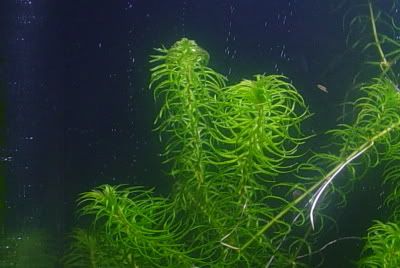This is going to be a quick plant profile on the beautiful plant, “Anacharis”.
Anacharis, also know as “Elodea”, is a very common, easy to grow aquarium plant.
Elodea is a genus of 6 species of aquatic plants often called the waterweeds described as a genus in 1803. Classified in the frog’s-bit family (Hydrocharitaceae), Elodea is native to the Americas and is also widely used as aquarium decoration and laboratory demonstrations of cellular activities. It lives in fresh water. An older name for this genus is Anacharis, which serves as a common name in North America.
Elodea canadensis, sometimes called American or Canadian water weed or pond weed, is widely known as the generic water weed. The use of these names causes it to be confused with similar-looking plants, like Brazilian elodea (Egeria densa) or hydrilla (Hydrilla verticillata). American water weed is an attractive aquarium plant and is a good substitute for Brazilian elodea. It can be used for science experiments in classrooms demonstrating how plants use carbon dioxide with the usage of bromothymol blue.
The American water weed lives entirely underwater with the exception of small white flowers which bloom at the surface and are attached to the plant by delicate stalks. It produces winter buds from the stem tips that overwinter on the lake bottom. It also often overwinters as an evergreen plant in mild climates. In the Autumn, leafy stalks will detach from the parent plant, float away, root, and start new plants. This is the American water weed's most important method of spreading, while seed production plays a relatively minor role. Seed reproduction is rarely used. As mentioned above, they break off, get replanted in the substrate, and then grow new plants. This does not happen often in aquariums, unless the plants are unhealthy.
————————————
I personally have used and kept this plant for over 2 years.
It grows best in warm water (76-80 degrees Fahrenheit). It can grown either floating or buried in substrate. I personally find I grows best in substrate.
Once your Anacharis stem gets to the surface of your water, you can trim it off at the top. Cut about 1/3 of the stem off and replant it. You need to make sure you tear off any of the lower leaves in the cut off stem, so they don’t decay and rot under your substrate.
Freshwater shrimp really like this plant and so do their young. It provided lush leaves for them to relax on.
I don’t believe this plant needs any other nutrition source. (Root tabs, liquid fertilizers, etc. Although, they will thrive when added)
Max size can be upwards of 3 feet long. Depending on what variation you get. (Narrow leaved or broad leaved)
ph: Needs to be kept anywhere from 6.5 - 7.5
Picture of Anacharis courtesy of Wikipedia.

Picture of Elodea canadensis

If you have any questions about this plant, PM me.
(https://en.m.wikipedia.org/wiki/Elodea)
Anacharis, also know as “Elodea”, is a very common, easy to grow aquarium plant.
Elodea is a genus of 6 species of aquatic plants often called the waterweeds described as a genus in 1803. Classified in the frog’s-bit family (Hydrocharitaceae), Elodea is native to the Americas and is also widely used as aquarium decoration and laboratory demonstrations of cellular activities. It lives in fresh water. An older name for this genus is Anacharis, which serves as a common name in North America.
Elodea canadensis, sometimes called American or Canadian water weed or pond weed, is widely known as the generic water weed. The use of these names causes it to be confused with similar-looking plants, like Brazilian elodea (Egeria densa) or hydrilla (Hydrilla verticillata). American water weed is an attractive aquarium plant and is a good substitute for Brazilian elodea. It can be used for science experiments in classrooms demonstrating how plants use carbon dioxide with the usage of bromothymol blue.
The American water weed lives entirely underwater with the exception of small white flowers which bloom at the surface and are attached to the plant by delicate stalks. It produces winter buds from the stem tips that overwinter on the lake bottom. It also often overwinters as an evergreen plant in mild climates. In the Autumn, leafy stalks will detach from the parent plant, float away, root, and start new plants. This is the American water weed's most important method of spreading, while seed production plays a relatively minor role. Seed reproduction is rarely used. As mentioned above, they break off, get replanted in the substrate, and then grow new plants. This does not happen often in aquariums, unless the plants are unhealthy.
————————————
I personally have used and kept this plant for over 2 years.
It grows best in warm water (76-80 degrees Fahrenheit). It can grown either floating or buried in substrate. I personally find I grows best in substrate.
Once your Anacharis stem gets to the surface of your water, you can trim it off at the top. Cut about 1/3 of the stem off and replant it. You need to make sure you tear off any of the lower leaves in the cut off stem, so they don’t decay and rot under your substrate.
Freshwater shrimp really like this plant and so do their young. It provided lush leaves for them to relax on.
I don’t believe this plant needs any other nutrition source. (Root tabs, liquid fertilizers, etc. Although, they will thrive when added)
Max size can be upwards of 3 feet long. Depending on what variation you get. (Narrow leaved or broad leaved)
ph: Needs to be kept anywhere from 6.5 - 7.5
Picture of Anacharis courtesy of Wikipedia.
Picture of Elodea canadensis
If you have any questions about this plant, PM me.
(https://en.m.wikipedia.org/wiki/Elodea)
Last edited:




